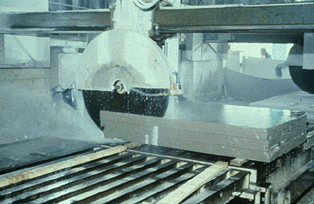
Blocks of limestone being sawed to size.
Indiana Limestone, which is a Mississippian-age grainstone of very uniform texture and grade, has gained world-wide acceptance as a premier dimension stone. The Salem Limestone, which is the geologic formational name for this carbonate unit, crops out in a belt that trends southward from Stinesville in Monroe County to Bedford in Lawrence County. The outcrop belt varies in width from about a mile to nearly 10 miles near Bedford.
The earliest known Indiana Limestone quarry was opened southeast of Stinesville in 1827 by Richard Gilbert. In 1928, the zenith of American-stone architecture, Indiana furnished 14.5 million cubic feet of dimension stone. At present, nine quarries extract the Salem Limestone. Most of the quarries use modern diamond belt saws to dimension the quarry blocks and air bags to turn down the cuts. Individual quarry blocks are broken using the time-honored method of driving steel wedges between half-shell slips or feathers that are placed in holes drilled by pneumatic star bits.

The Empire State Building in New York City is clad in Indiana Limestone.
Indiana Limestone is a freestone, which means that it exhibits no preferential direction of splitting and can, therefore, be cut and carved in an almost limitless variety of shapes and sizes. This property allows the stone to be planed, turned on a lathe, sawed, and hand worked to match the requirements of the most demanding architectural designs. Indiana Limestone exhibits three colors: gray, buff, and variegated, which includes patterns of both gray and buff.
Did you know:
- That nearly 2.7 million cubic feet of Indiana Limestone is quarried each year?
- That, although a relatively small industry, the Indiana Limestone industry generates about $26 million annually in revenue?
- That Indiana Limestone can be quarried and milled with greater efficiency, in terms of energy consumed, than most competing building materials?
- That Indiana Limestone has stood the test of time in structures all over the world where its strength, beauty, and durability have made it the material of choice in many older load-bearing structures as well as cladding stone in the modern context?
- That the Indiana Limestone industry employs stone cutters and carvers whose skills in working limestone into complex shapes and into art forms remain world class?
Performance
To those interested in the performance of Indiana Limestone as a building material, the following information will be of interest:
PROPERTY |
VALUE |
TEST PROCEDURE |
|---|---|---|
Ultimate compressive strength of dry specimens |
4,000 psi minimum* |
ASTM C170 |
Modulus of rupture of dry specimens |
700 psi minimum** |
ASTM C99 |
Absorption |
7.5 percent maximum |
ASTM C97 |

Beautiful Indiana Limestone adorns the U.S. Holocaust Memorial and Museum in Washington, D.C.
*Compressive-strength values of most Indiana Limestone products indicate minimum values in excess of 4,000 psi,
but this value is listed as an engineering reference.
**Windload and other bending forces are typically calculated at 1,000 psi for modulus of rupture.
Indiana Limestone is chemically pure, averaging 97 percent plus calcium carbonate and 1.2 percent calcium-magnesium carbonate, thus qualifying the material as a chemical stone.
For more information on Indiana Limestone, contact the Mineral Resources Section of the Indiana Geological Survey at 812-855-2687, or contact the Indiana Limestone Institute at:
Indiana Limestone Institute of America, Inc.
 Indiana Limestone Institute of America, Inc.
Indiana Limestone Institute of America, Inc. Suite 400
Stone City Bank Building
Bedford, IN 47421
(812) 275-4426
Web site: http://www.ILIAI.com/


